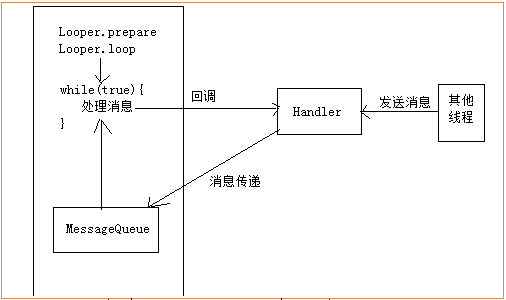Android异步消息处理
最近看了《Android内核剖析》这本书,将学习笔记整理如下
1. 异步消息线程
异步消息线程不同一般线程的是,它的线程run方法有一个无限循环,没循环一次,从其内部的消息队列中取出一个消息并调用回调函数进行处理。如果消息队列为空,线程暂停,直到消息队列中有新的消息。
一般而言有两种需求需要用到异步线程处理:
(1) 任务需要常驻
(2) 任务需要根据外部传递的消息做出不同的操作
2. Android异步线程的实现方法
在线程的内部有一个或多个Handler对象,外部程序通过该handler对象向线程发送异步消息,消息经由Handler传递到MessageQueue对象中。线程内部只能包含一个MessageQueue对象,线程主执行函数从MessageQueue中读取消息,并回调Handler对象中的回调函数handleMessage()。下面的代码是一个简单的实例。
class LooperThread extends Thread {
public Handler mHandler;
public void run() {
Looper.prepare();
mHandler = new Handler() {
public void handleMessage(Message msg) {
// process incoming messages here
}
};
Looper.loop();
}
}
2.1 Looper
Looper的作用有两点,第一是调用静态函数prepare()为线程创建一个消息队列;第二是调用静态函数loop(),使调用该函数的线程进行无限循环,并从消息队列中读取消息。
(1)调用prepare()函数
public static final void prepare() {
if (sThreadLocal.get() != null) {
throw new RuntimeException("Only one Looper may be created per thread");
}
sThreadLocal.set(new Looper());
}
//Looper构造函数
private Looper() {
mQueue = new MessageQueue();
mRun = true;
mThread = Thread.currentThread();
}
在代码中,变量sThreadLocal的类型是ThreadLocal,该类的作用是提供“线程局部存储”,从变量的作用域来理解下这个概念。
| 函数成员变量-------------------------------- | 仅在函数内部有效 |
| 类成员变量 --------------------------------- | 仅在对象内部有效 |
| 线程局部存储(TLS)变量-------------------- | 在本线程内的任何对象内保持一致 |
| 类静态变量------------------------------------ | 在本进程内的任何对象内保持一致 |
| 跨进程通信(IPC)变量----------------------- | 一般使用Binder进行定义,在所有进程中保持一致 |
从上述的代码可以看到,一个线程只允许创建一个Looper对象,这是因为每个Looper对象都会创建一个MessageQueue对象,一个异步线程中只能有一个消息队列,所以也就只能有一个Looper对象
(2)调用loop()函数
public static final void loop() {
Looper me = myLooper();
MessageQueue queue = me.mQueue;
// Make sure the identity of this thread is that of the local process,
// and keep track of what that identity token actually is.
Binder.clearCallingIdentity();
final long ident = Binder.clearCallingIdentity();
while (true) {
// might block 如果队列为空,则当前线程就会被挂起,next()函数内部会暂停线程
Message msg = queue.next();
if (msg != null) {
if (msg.target == null) {
// No target is a magic identifier for the quit message.
return;
}
if (me.mLogging!= null) me.mLogging.println(
">>>>> Dispatching to " + msg.target + " "
+ msg.callback + ": " + msg.what
);
//回调函数完成对消息的处理。msg.target的类型是Handler,msg最终交予handleMessage()处理
msg.target.dispatchMessage(msg);
if (me.mLogging!= null) me.mLogging.println(
"<<<<< Finished to " + msg.target + " "
+ msg.callback);
// Make sure that during the course of dispatching the
// identity of the thread wasn't corrupted.
final long newIdent = Binder.clearCallingIdentity();
if (ident != newIdent) {
Log.wtf("Looper", "Thread identity changed from 0x"
+ Long.toHexString(ident) + " to 0x"
+ Long.toHexString(newIdent) + " while dispatching to "
+ msg.target.getClass().getName() + " "
+ msg.callback + " what=" + msg.what);
}
//回收message对象占用的系统资源
msg.recycle();
}
}
}
2.2 MessageQueue
消息队列采用排队方式对消息进行处理,即先到的消息会先得到处理,但如果消息本身指定了被处理的时刻,则必须等到该时刻才能处理该消息。
2.3 Handler
尽管MessageQueue提供了直接读/写的函数接口,但对于应用程序员而言,一般不直接读/写消息队列。
程序员一般使用Handler类向消息队列发送消息,并重载Handler的handleMessage函数添加消息处理代码。
handler对象只能添加到有消息队列的线程中,否则会发生异常。因此,在构造Handler对象前,必须已经执行过Looper.prepare(),但prepare()不能被执行两次。
一个线程中可以包含多个Handler对象。在Looper.loop函数中,不同的Message对应不同的Handler对象,从而回调不同的handleMessage函数。
异步消息处理线程处理用于多线程的消息传递外,它还和跨进程调用(IPC)一起被使用,用于实现异步跨进程调用。

